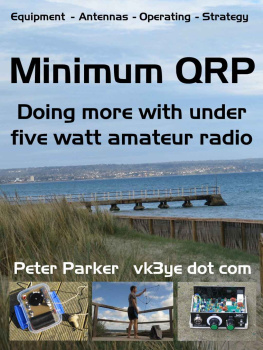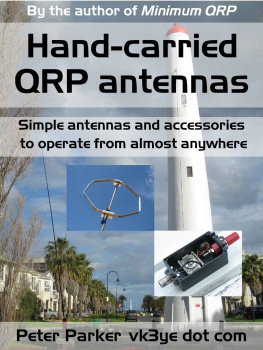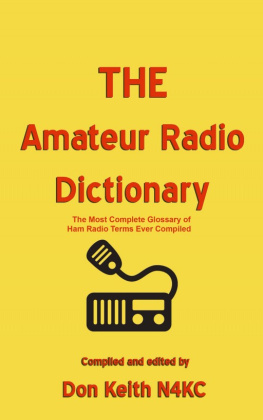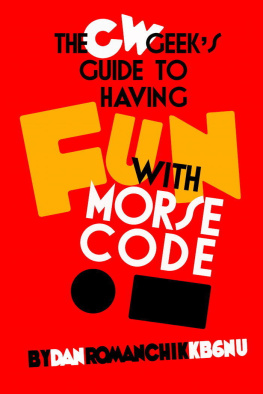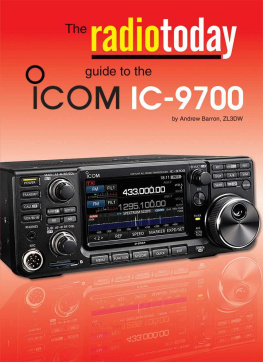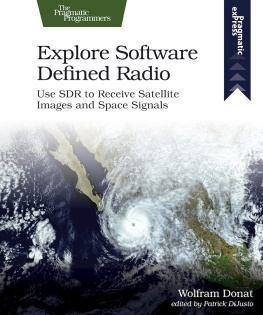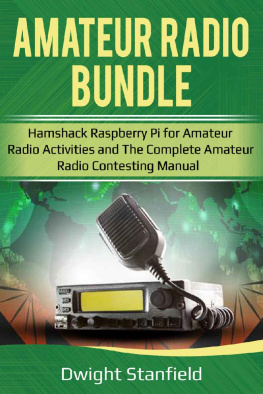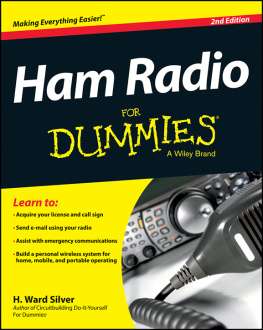Theres numerous circuits, kits and built up QRP transmitters, but how do you successfully use them? YouTube demonstrations shed some light but can be tightly edited, omitting the preparation, listening and calling that occurred beforehand. Magazine and web articles also help but space limitations can mean that authors cant always go into sufficient detail or that information is fragmented.
Minimum QRP aims to be a comprehensive operating manual for anyone who wants more from their modest station and antenna. While most space is devoted to bands, activity patterns and operating techniques, youll also find significant discussion of equipment, antennas and modes.
Its for a broad readership, including newcomers, old timers and those returning to amateur radio from a spell away. For this I ask forbearance from the more experienced who may find parts of it basic. However the section on operating, in particular, should be widely useful whether running five or a hundred watts.
If nothing else I hope that Minimum QRP encourages you to explore different bands, modes and facets of amateur radio. Almost all can be done with QRP. In many cases the personal involvement will be greater, making them even more fulfilling.
INTRODUCTION
1.1 Why QRP?
You crave for the mystery of who may come back to your calls. You love contacting the outside world from the remotest of mountains, islands or deserts independent of commercial phone, satellite and data networks. You wish to pit your skills against the limits of radio signal propagation. Or you enjoy communicating with gear you built yourself. These are just some of the motivations for under 5 watt amateur radio, or QRP as it is more widely known.
QRP has many diverse sub-interests. All are united by the idea of doing more with less. Different understandings of this add to the variety that is QRP today.
If less to you merely means the lowest possible power then anything else that can make it go further is fair play. That means aspiring to the best location, antenna, equipment and operating skills. Your station may be, as the Amateur Code defines, state of the art. Youd hear and work DX stations that those with more modest installations cannot. Whether you go to these lengths or not, be thankful that some hams do because they may be the first and sometimes only ones to hear your QRP signal.
Another species of QRPer emphasises simplicity. Basic gear and wire antennas are their keywords. They derive great satisfaction from lashing together a few components and working stations hundreds of kilometres away a few hours later. Such a minimalist transmitter may be confined to the one frequency with results highly subject to activity and conditions. However the thrill of even a few contacts with a simple homebrew rig can give a bigger buzz than a larger number made on a black box. Extra kudos if the circuit is simple enough to memorise and draw on the back of a QSL card.

Somewhat related is the scrooge QRPer. Their motivation is saving money, whether through necessity or desire. Their equipment will be assembled from salvaged items, bought cheaply from hamfests or ordered online. You wont find too many late model rigs in the scrooge QRPers shack. However there may still be valve equipment, either because it happened to be going cheaply at the time, or because it appeals for nostalgic reasons.
This brings us to the boatanchor radio movement, where old hams seek to recreate the dream station of their youth (which they might not have afforded back then). This can intersect with QRP interests where QRP HF CW or VHF AM equipment is involved. A somewhat younger set is attracted to basic 1970s radios such as the Yaesu FT-7 or Kenwood TS-120V. Even today these can form the basis of a simple but effective HF QRP station.
Amateurs in countries with novice or foundation licences are sometimes legally restricted to 10 watts or less. Such low power experience can help develop operator skill. Results with QRP can be so satisfying that many stick with low power even after they upgrade their licence.
Housing arrangements can make QRP the natural choice. This is particularly for those in units or apartments where high power can break into neighbours RF-susceptible appliances or high noise levels make receiving difficult. The power limits of some antennas (e.g. magnetic loops) and electromagnetic emission exposure concerns may mean a choice between operating QRP or not at all.
Amateurs who go hiking, mountain climbing or kayaking often find a grab and go portable QRP station great for keeping in touch with the outside world. Outdoors QRP is one of the fastest growing aspects of the hobby thanks to lighter gear and organised activities such as the Summits Of The Air awards program.

QRP becomes necessity rather than choice when hand-carrying everything over long distances. The lower noise on receive compared to home is a real treat for the suburban amateur and contacts with other QRP stations become much easier. Even if there are no nearby mountains, local parks, rivers and beaches can provide welcome relief from ever-increasing RF noise levels.
One QRPer youll rarely hear on air is the experimenter. Theyre too busy tinkering; its construction rather than operating that piques their interest most. QRP components today are cheap and readily available in contrast to the fears of 30 years ago. And a technical background is less necessary than for other branches of experimental radio.

While QRP is generally associated with licensed amateur radio, this is not necessarily always the case. Legal CB, FRS or 446 MHz equipment in most countries is by default QRP. And licence-free UHF data and wi-fi modules open up a range of activities, with good antennas allowing several kilometres range.
Developers find QRP a great test bed for work with new modes and circuit techniques. Advances have been numerous. Digital modes such as WSJT and WSPR redefine what can be done with low power. QRP software defined radio kits are readily available, economically providing features previously found only on high-end transceivers. Programmable electronics such as PIC and Arduino married with cheap direct digital synthesiser modules changed the way we generate RF and made multiband gear easier. Radio magazines, websites and now YouTube contain many experimenter contributions. And the back issues of old magazines are often online a boon for those recreating or restoring old-style equipment.
Thirty years ago when purchased ham gear was bulky and power-hungry, developers like W1CER/W1FB, W7ZOI, NN1G, N6KR, VE7QK, ZL2BMI and KD1JV became renowned for their feather-light transceiver designs. Many were turned into kits sold by a thriving cottage industry from the 1990s. Only later did larger manufacturers recognise the appeal of portable QRP, with some of their models becoming runaway successes.

